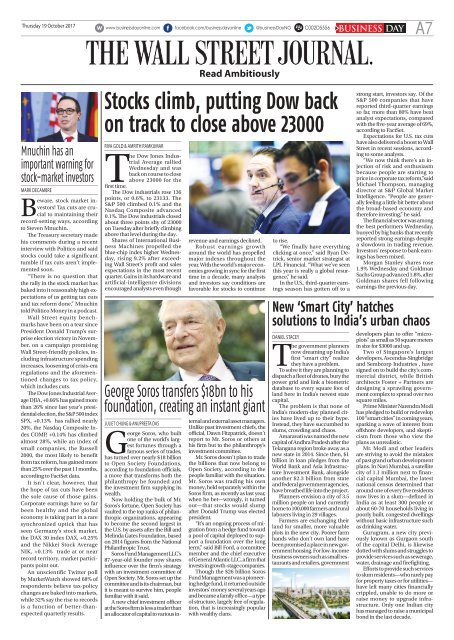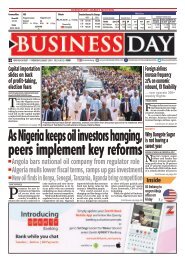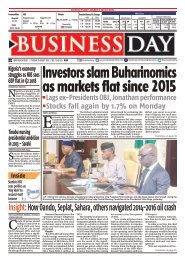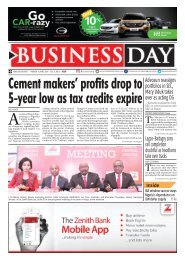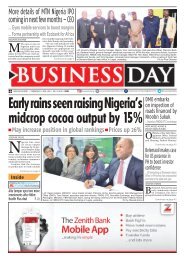BusinessDay 19 Oct 2017
Create successful ePaper yourself
Turn your PDF publications into a flip-book with our unique Google optimized e-Paper software.
Thursday <strong>19</strong> <strong>Oct</strong>ober <strong>2017</strong><br />
C002D5556<br />
BUSINESS DAY<br />
A7<br />
Mnuchin has an<br />
important warning for<br />
stock-market investors<br />
MARK DECAMBRE<br />
Beware, stock market investors!<br />
Tax cuts are crucial<br />
to maintaining their<br />
record-setting ways, according<br />
to Steven Mnuchin.<br />
The Treasury secretary made<br />
his comments during a recent<br />
interview with Politico and said<br />
stocks could take a significant<br />
tumble if tax cuts aren’t implemented<br />
soon.<br />
“There is no question that<br />
the rally in the stock market has<br />
baked into it reasonably high expectations<br />
of us getting tax cuts<br />
and tax reform done,” Mnuchin<br />
told Politico Money in a podcast.<br />
Wall Street equity benchmarks<br />
have been on a tear since<br />
President Donald Trump’s surprise<br />
election victory in November,<br />
on a campaign promising<br />
Wall Street-friendly policies, including<br />
infrastructure spending<br />
increases, loosening of crisis-era<br />
regulations and the aforementioned<br />
changes to tax policy,<br />
which includes cuts.<br />
The Dow Jones Industrial Average<br />
DJIA, +0.66% has gained more<br />
than 26% since last year’s presidential<br />
election, the S&P 500 index<br />
SPX, +0.13% has rallied nearly<br />
20%, the Nasdaq Composite Index<br />
COMP, +0.14% has climbed<br />
almost 28%, while an index of<br />
small companies, the Russell<br />
2000, the most likely to benefit<br />
from tax reform, has gained more<br />
than 25% over the past 11 months,<br />
according to FactSet data.<br />
It isn’t clear, however, that<br />
the hope of tax cuts have been<br />
the sole cause of those gains.<br />
Corporate earnings have so far<br />
been healthy and the global<br />
economy is taking part in a rare<br />
synchronized uptick that has<br />
seen Germany’s stock market,<br />
the DAX 30 index DAX, +0.25%<br />
and the Nikkei Stock Average<br />
NIK, +0.13% trade at or near<br />
record territory, market participants<br />
point out.<br />
An unscientific Twitter poll<br />
by MarketWatch showed 68% of<br />
respondents believe tax-policy<br />
changes are baked into markets,<br />
while 32% say the rise to records<br />
is a function of better-thanexpected<br />
quarterly results.<br />
Read Ambitiously<br />
Stocks climb, putting Dow back<br />
on track to close above 23000<br />
RIVA GOLD & AMRITH RAMKUMAR<br />
The Dow Jones Industrial<br />
Average rallied<br />
Wednesday and was<br />
back on course to close<br />
above 23000 for the<br />
first time.<br />
The Dow industrials rose 136<br />
points, or 0.6%, to 23133. The<br />
S&P 500 climbed 0.1% and the<br />
Nasdaq Composite advanced<br />
0.1%. The Dow industrials closed<br />
about three points shy of 23000<br />
on Tuesday after briefly climbing<br />
above that level during the day.<br />
Shares of International Business<br />
Machines propelled the<br />
blue-chip index higher Wednesday,<br />
rising 9.2% after exceeding<br />
Wall Street’s profit and sales<br />
expectations in the most recent<br />
quarter. Gains in its hardware and<br />
artificial-intelligence divisions<br />
encouraged analysts even though<br />
George Soros transfers $18bn to his<br />
foundation, creating an instant giant<br />
JULIET CHUNG & ANUPREETA DAS<br />
George Soros, who built<br />
one of the world’s largest<br />
fortunes through a<br />
famous series of trades,<br />
has turned over nearly $18 billion<br />
to Open Society Foundations,<br />
according to foundation officials,<br />
a move that transforms both the<br />
philanthropy he founded and<br />
the investment firm supplying its<br />
wealth.<br />
Now holding the bulk of Mr.<br />
Soros’s fortune, Open Society has<br />
vaulted to the top ranks of philanthropic<br />
organizations, appearing<br />
to become the second largest in<br />
the U.S. by assets after the Bill and<br />
Melinda Gates Foundation, based<br />
on 2014 figures from the National<br />
Philanthropic Trust.<br />
Soros Fund Management LLC’s<br />
87-year-old founder now shares<br />
influence over the firm’s strategy<br />
with an investment committee of<br />
Open Society. Mr. Soros set up the<br />
committee and is its chairman, but<br />
it is meant to survive him, people<br />
familiar with it said.<br />
A new chief investment officer<br />
at the Soros firm is less a trader than<br />
an allocator of capital to various in-<br />
revenue and earnings declined.<br />
Robust earnings growth<br />
around the world has propelled<br />
major indexes throughout the<br />
year. With the world’s major economies<br />
growing in sync for the first<br />
time in a decade, many analysts<br />
and investors say conditions are<br />
favorable for stocks to continue<br />
ternal and external asset managers.<br />
Unlike past investment chiefs, the<br />
official, Dawn Fitzpatrick, doesn’t<br />
report to Mr. Soros or others at<br />
his firm but to the philanthropy’s<br />
investment committee.<br />
Mr. Soros doesn’t plan to trade<br />
the billions that now belong to<br />
Open Society, according to the<br />
people familiar with the situation.<br />
Mr. Soros was trading his own<br />
money, held separately within the<br />
Soros firm, as recently as last year,<br />
when he bet—wrongly, it turned<br />
out—that stocks would slump<br />
after Donald Trump was elected<br />
president.<br />
“It’s an ongoing process of migration<br />
from a hedge fund toward<br />
a pool of capital deployed to support<br />
a foundation over the long<br />
term,” said Bill Ford, a committee<br />
member and the chief executive<br />
of General Atlantic LLC, a firm that<br />
invests in growth-stage companies.<br />
Though the $26 billion Soros<br />
Fund Management was a pioneering<br />
hedge fund, it returned outside<br />
investors’ money several years ago<br />
and became a family office—a type<br />
of structure, largely free of regulation,<br />
that is increasingly popular<br />
with wealthy clans.<br />
to rise.<br />
“We finally have everything<br />
clicking at once,” said Ryan Detrick,<br />
senior market strategist at<br />
LPL Financial. “What we’ve seen<br />
this year is really a global resurgence,”<br />
he said.<br />
In the U.S., third-quarter earnings<br />
season has gotten off to a<br />
DANIEL STACEY<br />
strong start, investors say. Of the<br />
S&P 500 companies that have<br />
reported third-quarter earnings<br />
so far, more than 80% have beat<br />
analyst expectations, compared<br />
with the five-year average of 69%,<br />
according to FactSet.<br />
Expectations for U.S. tax cuts<br />
have also delivered a boost to Wall<br />
Street in recent sessions, according<br />
to some analysts.<br />
“We now think there’s an injection<br />
of risk and enthusiasm<br />
because people are starting to<br />
price in corporate tax reform,”said<br />
Michael Thompson, managing<br />
director at S&P Global Market<br />
Intelligence. “People are generally<br />
feeling a little bit better about<br />
the broad-based economy and<br />
therefore investing,” he said.<br />
The financial sector was among<br />
the best performers Wednesday,<br />
buoyed by big banks that recently<br />
reported strong earnings despite<br />
a slowdown in trading revenue.<br />
Investors’ response to bank earnings<br />
has been mixed.<br />
Morgan Stanley shares rose<br />
1.9% Wednesday and Goldman<br />
Sachs Group advanced 1.8%, after<br />
Goldman shares fell following<br />
earnings the previous day.<br />
New ‘Smart City’ hatches<br />
solutions to India’s urban chaos<br />
The government planners<br />
now dreaming up India’s<br />
first “smart city” realize<br />
they have a problem.<br />
To solve it they are planning to<br />
dispatch a fleet of drones, bury the<br />
power grid and link a biometric<br />
database to every square foot of<br />
land here in India’s newest state<br />
capital.<br />
The problem is that none of<br />
India’s modern-day planned cities<br />
have lived up to their hype.<br />
Instead, they have succumbed to<br />
slums, crowding and chaos.<br />
Amaravati was named the new<br />
capital of Andhra Pradesh after the<br />
Telangana region broke away as a<br />
new state in 2014. Since then, $1<br />
billion in loan pledges from the<br />
World Bank and Asia Infrastructure<br />
Investment Bank, alongside<br />
another $2.3 billion from state<br />
and federal government agencies,<br />
have breathed life into the project.<br />
Planners envision a city of 3.5<br />
million people on land currently<br />
home to 100,000 farmers and rural<br />
laborers living in 29 villages.<br />
Farmers are exchanging their<br />
land for smaller, more valuable<br />
plots in the new city. Poorer farm<br />
hands who don’t own land have<br />
been promised a place in new government<br />
housing. For low-income<br />
business owners such as small restaurants<br />
and retailers, government<br />
developers plan to offer “microplots”<br />
as small as 50 square meters<br />
in size for $3000 and up.<br />
Two of Singapore’s largest<br />
developers, Ascendas-Singbridge<br />
and Sembcorp Industries , have<br />
signed on to build the city’s commercial<br />
district, while British<br />
architects Foster + Partners are<br />
designing a sprawling government<br />
complex to spread over two<br />
square miles.<br />
Prime Minister Narendra Modi<br />
has pledged to build or redevelop<br />
100 “smart cities” in coming years,<br />
sparking a wave of interest from<br />
offshore developers, and skepticism<br />
from those who view the<br />
plans as unrealistic.<br />
Mr. Modi and other leaders<br />
are striving to avoid the mistakes<br />
of past grand urban development<br />
plans. In Navi Mumbai, a satellite<br />
city of 1.1 million next to financial<br />
capital Mumbai, the latest<br />
national census determined that<br />
around one of every five residents<br />
now lives in a slum—defined in<br />
India as at least 300 people or<br />
about 60-70 households living in<br />
poorly built, congested dwellings<br />
without basic infrastructure such<br />
as drinking water.<br />
Gurugram, a new city previously<br />
known as Gurgaon south<br />
of the capital Delhi, is likewise<br />
dotted with slums and struggles to<br />
provide services such as sewerage,<br />
water, drainage and firefighting.<br />
Efforts to provide such services<br />
to slum residents—who rarely pay<br />
for property taxes or for utilities—<br />
have left many cities financially<br />
crippled, unable to do more or<br />
raise money to upgrade infrastructure.<br />
Only one Indian city<br />
has managed to raise a municipal<br />
bond in the last decade.


